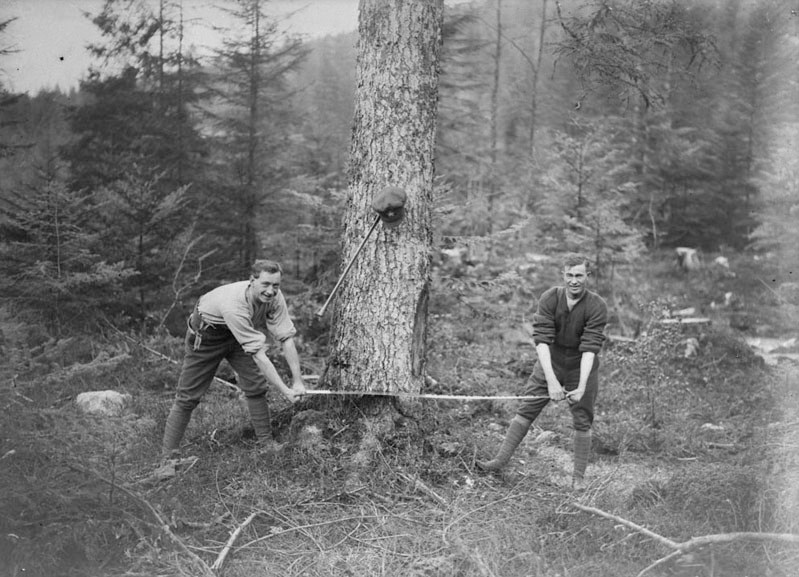When my cousin Brian Lesko and I discovered the lost and forgotten gravesite of my uncle Walter last summer in Winnipeg's Brookside Cemetery it got me thinking there was one more visit I had to do.
Eleven years earlier I had found the final resting place of my maternal grandfather Peter Kravcenko in the cemetery's military section. He too was a forgotten man. He died alone in 1964 in a room he rented in an older part of the city.
I have no memories of grampy Pete, but growing up I heard stories he became estranged from his family, largely due to illness from alcoholism. But my mother deeply loved him, as did most of his grandchildren. What is even less known about grampy Pete was that he was a First World War hero. He did so while serving with the Canadian Expeditionary Force's Canadian Forestry Corps, the lumberjack heroes of Canada's First World War army.
In 2017 this largely forgotten specialized military unit is celebrating its 100th anniversary of its crucially important arrival and service to the Aquitaine Region of France. These lumberjack heroes are being honoured this year for their service.
This little known group was formed on Feb. 16, 1916 following a request from British Colonial Secretary Andrew Bonar Law to the Governor General of Canada to have Canadian lumbermen help with the cutting and processing of timber that was needed for the war effort in Europe.
More than 24,000 Canadian men, who were joined by soldiers from other countries, served with the forestry corps in various parts of Europe by the time the war ended.
They processed timber for the construction of barracks, roads, trenches, ammunition boxes, and other supplies. When the war was over two years later their work had played a crucially important contribution to many of the great battles, including Vimy Ridge. In 1917, men from the Canadian corps serving in France had delivered 131,700,000 board feet of timber and in 1918, this figure more than tripled to 424,300,000. During their time in France, they also produced more than 200,000 tons of fuel and slabs. They were also called upon to help on the frontlines. They stockpiled artillery ammunition and helped evacuate the wounded. As well, some Corps members, who were trained as infantry soldiers, were called upon to serve in combat.
My grandfather enlisted with the 197th Overseas Battalion on March 18, 1916. Pte. Kravcenko was assigned in 1917 to 30 Company of the Canadian Forestry Corps. His military records state he seriously injured his knee in 1918 while working with a crew to pull down a tree for lumber. He did recover and returned to duty. However, there was an interesting note on his service record for April 14, 1918 that states, “Being held at base – Russian.”
A few months earlier, Russia, which had been on the side of the Allies for most of the war – had sued for peace with the Germans. The Bolshevik Revolution was underway and Lenin was in power.
At about the same time back in Canada, thousands of Ukrainian-Canadians were being unjustly rounded up and imprisoned. There was fear in the country they would be disloyal to Canada and the Crown. However, grampy Pete's records go on to say he returned to active duty on May 19, 1918. He was honourably discharged from the military on March 23, 1919. When grampy Pete died, the Royal Canadian Legion ensured he had a full military funeral and burial. In the meantime, the Canadian Forestry Corps was reactivated again during the Second World War but the numbers were far smaller with about 7,000 serving. Following the war the corps was deactivated. For the next seven decades they were mostly forgotten until members of a research historical group based in France recently launched a project to ensure the soldiers from the Canadian Forestry Corps, along with their American and British counterparts, would be properly honoured.
In partnership with several communities throughout Gironde and the Lande, the volunteer-driven Corps Forestiers en Aquitaine, which is based in the southwest of France, came up with an idea to finally salute these unheralded heroes. It was appropriately called The Lumberjack Trail project.
About 140 First World War Canadian Forestry Corps soldiers are buried in France. One third of them are in small cemeteries in the Aquitaine region. The volunteer group has researched and identified their final resting place locations.
Last June and again in October, the heroism of these forestry corpsmen was honoured in several French communities with the inauguration of The Lumberjack Trail, which included the unveiling of commemorative plaques close to where these special lumberjacks lived and worked.
Grampy Pete deserves this recognition, as it is long overdue not only for him but for the other thousands of lumberjack colleagues from Canada, the U.S. and Great Britain. They all did their part honourably for their countries.
Like their battlefield comrades, they should never be forgotten.



